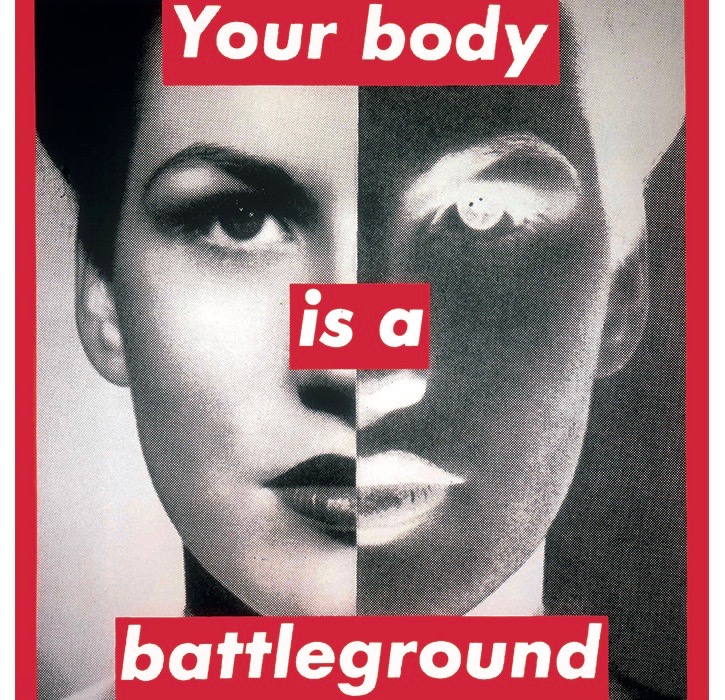Election Editorial: Setting the Stage for the 2017 Battleground

Barbara Kruger, “Untitled (Your Body is a Battleground),” 1989. Photographic silkscreen on vinyl. 112 x 112 inches. The Broad.
In less than 24 hours, Donald Trump will officially become President of the United States of America. There is essentially nothing I can think of that makes me comfortable with this fact. Here in Los Angeles, the palpable sense of disbelief that spread through the city after the election has evolved into fear and uncertainty. In the next few days, thousands of people will come together to voice these feelings and fight for their beliefs. In Los Angeles alone, the LAPD anticipates over 100,000 protesters from around the country. Several groups have reported their plans to block freeways and major streets. Many will also march on foot through the city, in particular the Downtown area.
On Saturday, cities around the nation will participate in the Women’s Rights March, also known as the Women’s March on Washington. In light of these events, visual symbols have surfaced to help protesters and marchers unite. Boxes labeled with all the rights currently at threat, hats with cat ears (pussy hats), and Trump piñatas are just a few of the objects that have become symbolic of the uprising against Trump and his foreboding administration. For me, this proliferation of visual tools is the only remotely positive thing happening right now. Are these first few weeks of 2017 a sign that craft, art, and creativity will play a larger role in our daily lives?
As someone who is constantly surrounded by visual expression, I am acutely aware that many outside the art world are not as comfortable using images to convey their beliefs. I myself am more inclined to use words rather than images to communicate. Thankfully, for all of us who are not able to create our own visual tools, we have artists to help.
One artist who never fails to offer images through which large groups can unite is Barbara Kruger. Seeking social agitation, provocation, and ultimately education, Kruger is an example of an artist who lends her artwork to political and social causes. In the next few days, her works will be the tools I use to voice my opinion. One work in particular will be immensely important and I offer it here for you to use as well.
“Untitled (Your Body is a Battleground),” 1989, is a photographic silkscreen on vinyl currently on view at the Broad museum in Los Angeles. Kruger originally conceived the piece as a poster made specifically for the Women’s March on Washington. Supporting legal abortion, birth control, and women’s rights, this image became widely used in the campaign against an effort to revoke Roe v. Wade. The poster was, and still is, a useful tool for both men and women seeking a visual symbol for their fight for women’s rights. It was pasted on walls in several cities around the world, including Berlin, Warsaw, and New York City. Showing how cyclical political and social issues have become, this image has recently resurfaced as a useful tool for those fighting for these same causes—legal abortion, birth control, and women’s rights to name a few.
The original poster is an example of how Kruger’s works defy the traditional museum or gallery setting. She makes pieces that are too large to display indoors, as well as public works for billboards, bus ads, and magazines or printed media. Similar works take over entire rooms or building façades to envelop the viewer both physically and psychologically. Kruger shows that art is not limited to a museum setting. Art can be expressed anywhere and culture can be born in the streets. In doing so, Kruger is part of a major revival of photomontage, specifically as a tool to positively impact society, a utopian notion that derives from Soviet artists who sought to address a mass audience and to transform existing systems of representation and communication.
“Untitled (Your Body is a Battleground)” addresses the viewer directly in an authoritative voice. The work demands the viewer to reflect upon his or her own identity and illustrates how language and image define our understanding of cultural systems. Transcending the boundaries between advertising and propaganda, Kruger delivers her message in a way not so much as to tell the viewer what to think or do, but more so to illustrate the positions available and incite conversations.
Beginning with Trump’s inauguration tomorrow, these conversations will become increasingly important to listen to and partake in. With the advent of his administration, we can no longer afford to be bystanders. For now, I hope these next few days inspire people to participate, if not through art, then at least through conversation.
What's Your Reaction?
Annabel Keenan is a New York-based writer focusing on contemporary art, market reporting, and sustainability. Her writing has been published in The Art Newspaper, Hyperallergic, and Artillery Magazine among others. She holds a B.A. in Art History and Italian from Emory University and an M.A. in Decorative Arts, Design History, and Material Culture from the Bard Graduate Center.

